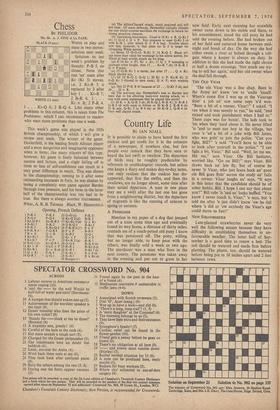Chess
BY PHI LIDOR
No. 66. A. J. FINK & Ua TANE.
WHITE (11 men)
mate in two moves: solution next week.
Solution to last week's problem by Stocchi: P-B 5, no threat. Note that one 'set' mate after Kt (Kt 5) moves, i.e. 2 Kt-B 5 is replaced by 3 after key 1 . . . Kt-B 7;
2 B-K 4. 1 . . . Kt x B; 2 P-K 4. 1 . . . Kt-Q 4; 2 R-Q 4. Like many other problems in this column, this is taken from The Problemist, which 1 can recommend to readers who want more problems than one a week.
This week's game, was played in the 1956 British championship, of which 1 will give a review next week. The winner of the game Heidenfeld, is the leading South African player and a most dangerous and imaginative opponent when in form; like many players of this type. however, his game is finely balanced between success and failure, and a slight falling off in form or loss of self-confidence can result in a very great difference in result. This was shown in the championship; coming to it after some outstanding successes in Italy, he was shaken by losing a completely won game against Barden through time pressure, and his form in the latter half of the championship was too bad to be true. But there is always another tournament. White, A. R. B. THOMAS Black, W. HEIDENFELD Opening, French Defence
•
P-R. 4 P-K 3 15 0-0 (c) P-K 5!
B-K 3 Q x Kt B-Kt 5
P x P B-R 6 Q-Q 1
Q x P R-K 1
R-K 4 (h) R-Kt 4 ch II-Kt 7 ch HxPch B x Kt ch -Q 4 P-Q 4 16 Kt-Q 2 (d)
3 Kt-Q B 3 Kt-K B 3 17 Kt-Kt 3 (e) 4 B-Kt 5 B-K 2 18 Q R-Q 1
5 P-K 5 K Kt-Q 2 19 P-K B 3 (f)
6 P-K R 4 P-Q B 4 20 P x P 7 B x li Q x 13 21 K-B 2 8 Kt-Kt 5 0-0 22 Kt x P
9 Kt-B 7 P x P 23 Kt-K 2 (g)
10 B-Q 3 (to Kt-Q B 3 24 Q-Q 6 11 Kt x R Kt(2) x P 25 R-R 2 12 Kt-B 3 Kt x Bch 26 K-R 1 13 Q x Ki P-K 4 27 K-Kt 1 14 Q-R 3 • 0-0 1 28 K-B I
29 Resigns (i)
(a) The Albin-Chatard attack, much analysed and still not clear. Of many defences, Heidenfeld typically chooses the one which counter-sacrifices the exchange in return for strong attacking chances. (b) Interesting innovation. Usual is 10 Kt x F1, Q-Kt 5 ch; I I Q-Q 2. Q x P. Text prepares to meet Q-Kt 5 ch with K-13 1, after which Q x P is bad. Trouble about new line, however, is that piece on Q 3 is target for advancing White pawns.
(c) Better 15 0-0-0, B-Kt 5; 16 R-0 2. Black sill, nas more than value for exchange in his centre pawns, but White at least avoids attack on his king. (d) if 16 Kt x P7, Kt x Kt; 17 Q x P intending to extricate other knight, then 17 ... Kt-K 7 ch; 18 K-R 2, Q x P mate.
(e) 17 Q-K Kt 3 is better, but after 17 . . . Q x Kt; Black should win. (f) Or 19 R-Q 2, Q-Q 1; 20 Kt x P, Kt-K 4!; 21 P-Q Kt 3 (forced to save rook), Q x P; with winning attack. (g) Not 23 P-K B 47 because of 23 ... Q-Kt 5 ch; and 24 .. . Q x R. (h) The previous day Heidenfeld's loss to Barden had been due to his allowing back-row mating attack, so it was with some uneasiness that he played this move!
(1) 29 K x B, Q-K 5 ch; 30 2, R-K 4!; 31 R-R 3 Q-B 5 ch with mate to follow or 30 K-B 2, R-B 4 ch: 31 K any, Q-Kt 5 or B 6 ch; or 30 K-B 1, Q-B 6 ch. Very well played attack.


































 Previous page
Previous page